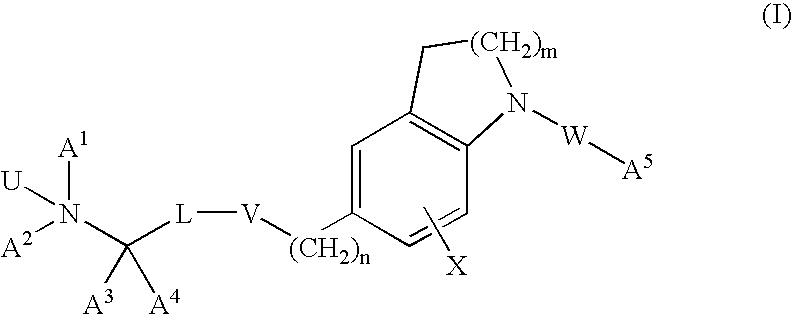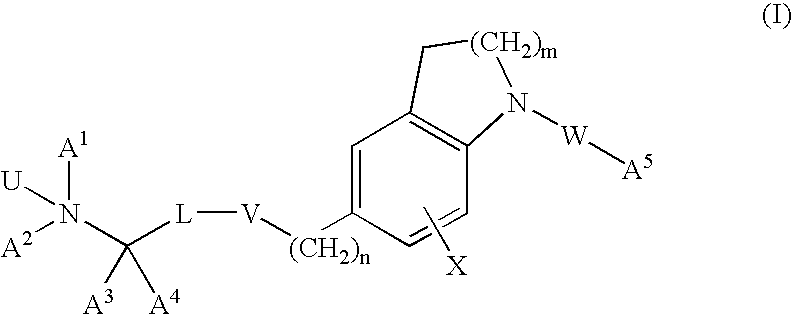Dihydroindole and tetrahydroquinoline derivatives
a technology of tetrahydroquinoline and dihydroindole, which is applied in the field of new drugs, can solve the problems of synergistic risk factors, ischemia or infarction, and ineffective synergistic risk factors, and achieve the effects of reducing plasma cholesterol levels, preventing hypercholesterolemia, and reducing the biosynthesis of cholesterol
- Summary
- Abstract
- Description
- Claims
- Application Information
AI Technical Summary
Benefits of technology
Problems solved by technology
Method used
Image
Examples
example 1
1.1
[0384]1,2,3,4-Tetrahydro-quinolin-6-ol can be prepared from quinolin-6-ol according to Moore; Capaldi; J.Org.Chem., 29, 1964, 2860 or Hoenel, Michael; Vierhapper, Friedrich W.; J.Chem.Soc.Perkin Trans. 1, 1980, 1933–1939.
1.2
[0385]To 750 mg (5 mmol) 1,2,3,4-Tetrahydro-quinolin-6-ol in 10 ml THF 950 mg (5 mmol) 4-chlorophenylchloroformate were added. The solution was stirred at RT for 30 min, 0.5 ml (6 mmol) pyridine were added and the solution was stirred for additional 30 min. The mixture was concentrated in vacuo and dissolved in EtOAc, water and 2M HCl was added. The inorganic phase was extracted with EtOAc, the combined organic phases were washed with water and dried over Na2SO4. Column chromatography on silica gel with CH2Cl2 / MeOH 49:1 yielded 600 mg (40%) 6-Hydroxy-3,4-dihydro-2H-quinoline-1-carboxylic acid 4-chloro-phenyl ester as colorless gum, MS: 303 (M, 1Cl).
1.3
[0386]To 304 mg (1 mmol) 6-Hydroxy-3,4-dihydro-2H-quinoline-1-carboxylic acid 4-chloro-phenyl ester in 4 ml DM...
example 2
2.1
[0394]To 9.7 g (65 mmol) 1,2,3,4-Tetrahydro-quinolin-6-ol in 90 ml CH2Cl2 13.7 g (62.8 mmol) di-tert.-butyl-dicarbonate were added. The solution was stirred at 50° C. for 5 h and at RT over night. The mixture was concentrated and dissolved in Et2O. A diluted aqueous solution of KHSO4 was added and the inorganic phase was extracted with Et2O, the combined organic phases were washed with brine and dried over Na2SO4. Column chromatography on silica gel with CH2Cl2 / MeOH 9:1 yielded 16.2 g (99%) 6-Hydroxy-3,4-dihydro-2H-quinoline-1-carboxylic acid tert-butyl ester as light yellow crystals, MS: 249 (M).
2.2
[0395]To 11.6 g (46.5 mmol) 6-Hydroxy-3,4-dihydro-2H-quinoline-1-carboxylic acid tert-butyl ester in 200 ml acetone 18.6 g (134.8 mmol) K2CO3 (powdered) and 13.7 g (115.7 mmol) 1,4-dibromobutane were added. The mixture was stirred at reflux for 4 h and at RT over night. The reaction mixture was filtered, and the filtrate was concentrated in vacuo. EtOAc and water were added, the inorg...
example 3
3.1
[0404]3.64 g (9.7 mmol) 6-[4-(Allyl-methyl-amino)-butoxy]-3,4-dihydro-2H-quinoline-1-carboxylic acid tert-butyl ester in 5 ml CH2Cl2 were treated with 3.5 ml TFA at 0° C., and the solution was stirred at 40° C. for 1 h. The solution was concentrated and the residue dissolved in a mixture of a saturated aqueous solution of NaHCO3 and ether. The inorganic phase was extracted with ether and the combined organic phases were washed with water and dried over Na2SO4 to yield 1.85 g (69%) Allyl-methyl-[4-(1,2,3,4-tetrahydro-quinolin-6-yloxy)-butyl]-amine, MS: 275 (MH+).
3.2
[0405]In analogy to example 3.1, 6-[4-(Allyl-methyl-amino)-but-2-enyloxy]-3,4-dihydro-2H-quinoline-1-carboxylic acid tert-butyl ester was converted to yield Allyl-methyl-[4-(1,2,3,4-tetrahydro-quinolin-6-yloxy)-but-2-enyl]-amine (crude) as orange oil, MS: 273 (MH+).
3.3
[0406]In analogy to example 3.1, 6-[5-(Allyl-methyl-amino)-pentyloxy]-3,4-dihydro-2H-quinoline-1-carboxylic acid tert-butyl ester was converted to yield A...
PUM
 Login to View More
Login to View More Abstract
Description
Claims
Application Information
 Login to View More
Login to View More - R&D
- Intellectual Property
- Life Sciences
- Materials
- Tech Scout
- Unparalleled Data Quality
- Higher Quality Content
- 60% Fewer Hallucinations
Browse by: Latest US Patents, China's latest patents, Technical Efficacy Thesaurus, Application Domain, Technology Topic, Popular Technical Reports.
© 2025 PatSnap. All rights reserved.Legal|Privacy policy|Modern Slavery Act Transparency Statement|Sitemap|About US| Contact US: help@patsnap.com



